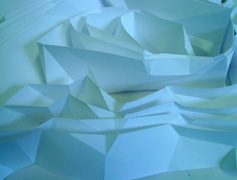|
Unit E 2005-2006 Staff Jonathan Dawes Guests Madeleine Adams Students Dheeraj Bishwakarma |
 Disruptive Pattern Material This year we have examined camouflage and its potential role within architecture. The unit has investigated patternmaking in various dimensions through the inhabitation of solid and surface constructions with differentiated light and tactile qualities. The ambition has been to create a device that can be applied to address mixture at various scales: redefining spatial hierarchies, mediating adjacencies and exploring new material composites. Analogous Constructs Fieldwork in Shibuya, Tokyo focussed upon interconnected urban spaces and the topological, material, and temporal properties they possessed, analogous to earlier studies. Individual mappings plotted emergent patterns: complex mixtures of use within single building envelopes, overlapping or singular ownerships that extend under, in-between and over layers of transport infrastructure, the orders of signage etc. Exclusive Context West Silvertown, East London became the subject of a group investigation and research document from which individual strategic interests were developed. A complex armature between segregated housing, park, industrial and waterfront conditions became the site for intervention. Hybrid Mixture Students were asked to respond strategically by mediating between isolated uses, inhabitants, social groups, territories. The group proposed a range of strategic models to exploit the overlaps and adjacencies present. The industrial scale and typology were 'diluted' by phasing patterns of change or by providing public amenities or facilities that blurred the boundaries between the current patterns of polarised occupation. Heterogeneous Fabric The resolution of built fabric was based upon a redefinition of individual surface, material and volumetric interests forming a range of approaches and applications: |